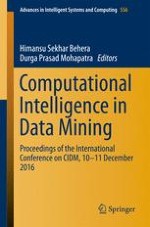The book presents high quality papers presented at the International Conference on Computational Intelligence in Data Mining (ICCIDM 2016) organized by School of Computer Engineering, Kalinga Institute of Industrial Technology (KIIT), Bhubaneswar, Odisha, India during December 10 – 11, 2016. The book disseminates the knowledge about innovative, active research directions in the field of data mining, machine and computational intelligence, along with current issues and applications of related topics. The volume aims to explicate and address the difficulties and challenges that of seamless integration of the two core disciplines of computer science.
